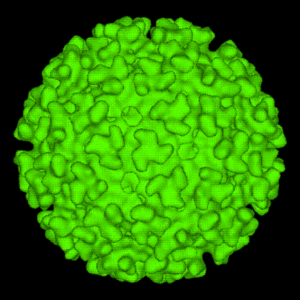| This article is still under construction. |
Family Togaviridae
Small, lipid- and protein-enveloped RNA viruses. The family includes pathogenic arboviruses (insect-borne virsuses) of the Alphavirus genus.
Genus Alphavirus
Single-stranded, linear, positive-sense RNA viruses, 60-70nm in diameter.

Important Serotypes
Several alphavirus strains have been isolated during equine and human epidemics of encephalitis in the Western Hemisphere. These epidemics have most often been attributed to:
Eastern EEV has North and South American antigenic variants. Western EEV is a recombinant between an Eastern EEV-like virus and a Sindbis-like virus. Western EEV also has two antigenic subtypes - WEE and Highlands J viruses. Considerable overlap exists between the various strains in terms of their geography, and potentially also in their antigenic properties and biological behaviour. Of the 6 subtypes of Venezuelan EEV (I-VI), significant outbreaks of equine encephalitis in the Western Hemisphere over the last two decades have been caused by IAB, IC and IE. Variant ID from Central America and variant IF from Brazil are considered endemic and typically demonstrate low pathogenicity for horses. These features are also typical of subtype II (Everglades) virus in Florida and types II, IV, V ad VI viruses.
Diseases
Arboviruses are the most common cause of equine encephalitis.
Distribution
Virus distribution is largely dictated by the distribution of appropriate vectors. Thus Eastern EEV can be found in a region extending from eastern Canada at its northern extremity, down throughout the Caribbean and in parts of Central and South America. The virus has also been identifed in the Philippines and may be present in Europe. Over the last two decades, Western EEV has rarely caused disease in the western United States, although it is found here in avian reservoir hosts. As well as producing disease outbreaks in Mexico, Venezuela and colombia, Venezuelan EEV has recently been recognized in Peru, Brazil, French Guiana and Trinidad.
Reservoirs
Togaviridae survive by asymptomatically infecting sylvatic hosts such as birds, small mammals, reptiles and amphibians. Overwintering occurs in these wild populations.
Vectors
During a blood meal, mosquito vectors transmit viral particles between wild animal hosts. Viruses that are able to penetrate the mosquito's gut can pass via the haemolymph to the oral glands. Here, viral replication is followed by the shedding of viral particles into the saliva and other oral secretions. Viral multiplication may not be necessary for transmission if the original blood meal contained sufficient numbers of viral particles. It is thought that the mosquito remains permanently infected. The most significant disease vectors for each viral serotype are:
- Eastern EEV: Aedes spp.
- Western EEV: Culex tarsalis
- Venezuelan EEV: Culex melanconium, Aedes spp., Phosphora spp.
Culiseta melanura is another vector for Eastern EEV. It feeds mostly on swamp birds, completing an enzootic cycle of viral transmission. C.melanura is thus an inhabitant of freshwater swamps and is not usually found in areas densely populated by equids. Epizootics and epidemics of Eastern EEV disease are propagated by Aedes spp. Western EEV persists in an enzootic cycle with passerine birds, transmitted by C.tarsalis. Other vectors or overwintering hosts for this serotype may include Dermacentor andersoni ticks, Triatoma sanguisuga (the assassin bug), and the cliff swallow bug (Oeciacus vicarius). Epidemic strains of Venezuelan EEV have infected mosquito species from several genera and this viral serotype may also be transmitted by ticks.
References
Bertone, J.J (2010) Viral Encephalitis in Reed, S.M, Bayly, W.M. and Sellon, D.C (2010) Equine Internal Medicine (Third Edition), Saunders, Chapter 12.
| Also known as: | EEV Alphavirus |